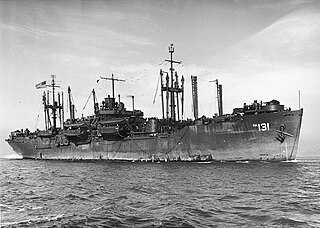
USS Bandera (APA-131) was a Haskell-class attack transport in service with the United States Navy from 1944 to 1946. She was scrapped in 1974.

USS Acubens (AKS-5) was an Acubens-class general stores issue ship commissioned by the U.S. Navy for service in World War II, named after the star Acubens, the alpha star in Cancer. She was responsible for delivering and disbursing goods and equipment to locations in the war zone.
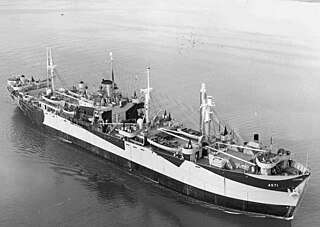
USS Baham (AK-122/AG-71) was a Basilan-class auxiliary ship, converted from a Liberty ship, commissioned by the United States Navy for service in World War II. She was first named after former Florida resident Elizabeth C. Bellamy, the daughter of General William Croom, and wife of Doctor Samuel C. Bellamy. She was renamed and commissioned after Baham, a star in constellation Pegasus. She was responsible for delivering troops, goods and equipment to locations in the war zone.

USS Riverside (APA-102) was a Bayfield-class attack transport in service with the United States Navy from 1944 to 1946. In 1948, she was sold into commercial service. She sank in Smyth Channel, Chile, in 1968.

USS Zaniah (AK-120) was a Basilan-class cargo ship commissioned by the United States Navy for service in World War II. She was responsible for delivering troops, goods and equipment to locations in the war zone.

USS Azimech (AK-124) was a Crater-class cargo ship commissioned by the US Navy for service in World War II, named after the Azimech, the other name of Spica, the brightest star in constellation Virgo. She was responsible for delivering troops, goods and equipment to locations in the war zone.

USS Kochab (AKS-6) was an Acubens-class general stores issue ship commissioned by the U.S. Navy for service in World War II. She was responsible for delivering and disbursing goods and equipment to locations in the war zone. The vessel was constructed by Delta Shipbuilding Co. of New Orleans, Louisiana and launched on 8 March 1944 under a Maritime Commission contract. After being acquired the U.S. Navy, the vessel was converted into a general stores ship and entered service on 4 November 1944. Kochab supported American operations in the Pacific Theater, sailing between US bases on Pacific islands. Following the war's end, Kochab sailed to the US with returning personnel and operated along the United States West Coast before being decommissioned on 17 April 1946. The vessel was then placed in reserve. Kochab was sold for scrap in 1965.
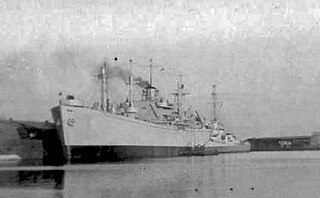
USS Luna (AKS-7) was a Liberty ship built in the United States during World War II. She was originally named for Harriet Hosmer, a neoclassical sculptor, considered the first female professional sculptor. She was converted shortly after completion to an Acubens-class general stores issue ship and renamed Luna, the latin name for the Moon. She was responsible for delivering and disbursing goods and equipment to locations in the war zone.
USS Iolanda (AKS-14) was an Acubens-class general stores issue ship commissioned by the U.S. Navy for service in World War II. She was responsible for delivering and disbursing goods and equipment to locations in the war zone.

USS Rockingham (APA/LPA-229) was a Haskell-class attack transport in service with the United States Navy from 1944 to 1947. She was scrapped in 1979.

USS Buckingham (APA-141) was a Haskell-class attack transport in service with the United States Navy from 1945 to 1946. She was scrapped in 1974.
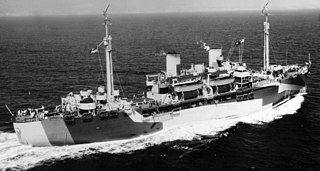
USS Appling (APA-58) was a Gilliam-class attack transport that served with the United States Navy from 1944 to 1946. She was scrapped in 1969.

USS Colusa (APA-74) was a Gilliam-class attack transport that served with the United States Navy from 1944 to 1946. She was scrapped in 1966.

USS Basilan (AG-68) was a Basilan-class miscellaneous auxiliary acquired by the U.S. Navy during World War II. The ship was designed as a combined barracks-stores-water distillation ship, but was later converted to an electronics repair ship. She spent her Navy career in the Pacific Ocean theatre of operations.
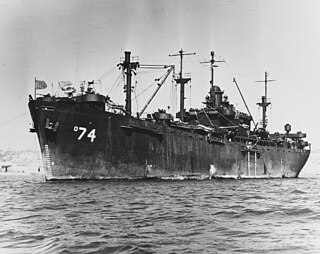
USS Coasters Harbor (AG-74) was a Basilan-class miscellaneous auxiliary acquired by the U.S. Navy during World War II. She was configured as a repair ship and sent to the Pacific Ocean just as the war ended. She was retained to participate in atomic testing at Bikini Atoll.

USS Kent Island (AG-78/AKS-26) was a Basilan-class miscellaneous auxiliary acquired by the U.S. Navy shortly before the end of World War II. She was used to transport personnel and cargo and was inactivated and disposed of shortly after the war.
USS Proton (AG-147/AKS-28) -- also known as USS LST-1078 – was an LST-542-class tank landing ship launched by the U.S. Navy during the final months of World War II. Proton served as a troop ship, a cargo ship and as an electronic parts supply ship for the U.S. Pacific Fleet and was decommissioned following the Korean War.
USS Chimon (AG-150/AKS-31) – also known as USS LST-1102 -- was an LST-511-class tank landing ship launched by the U.S. Navy during the final months of World War II. Chimon served as a transport and stores ship for the U.S. 7th Fleet, and was decommissioned after service in the Korean War.
USS Newcastle Victory (AK-233) was a Boulder Victory-class cargo ship acquired by the U.S. Navy during World War II. She served in the Pacific Ocean theatre of operations through the end of the war, and then returned to the United States of America for disposal.
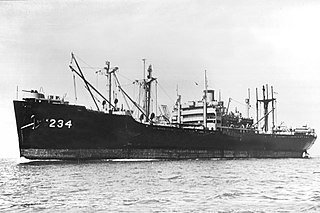
USS Bucyrus Victory (AK-234) was a Boulder Victory-class cargo ship acquired by the U.S. Navy during World War II. She served in the Pacific Ocean theatre of operations through the end of the war, earning one battle star, and then returned to the United States for disposal.

















